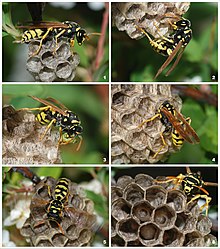Paper wasp
| Paper wasps | |
|---|---|
 |
|
| A young paper wasp queen (Polistes dominula) starting a new colony | |
| Scientific classification | |
| Kingdom: | Animalia |
| Phylum: | Arthropoda |
| Class: | Insecta |
| Order: | Hymenoptera |
| Suborder: | Apocrita |
| Family: | Vespidae |
| Subfamily: | Polistinae, Stenogastrinae, or Vespinae |
Paper wasps are 0.7 to 1.0 inch (1.8 to 2.5 cm) long wasps that gather fibers from dead wood and plant stems, which they mix with saliva, and use to construct water-resistant nests made of gray or brown papery material. Paper wasps are also sometimes called umbrella wasps, due to the distinctive design of their nests.
The name "paper wasps" typically refers to members of the vespid subfamily Polistinae, though it often colloquially includes members of the subfamilies Vespinae (hornets and yellowjackets) and Stenogastrinae, which also make nests out of paper. Twenty-two species of Polistes paper wasps have been identified in North America and approximately 300 species have been identified worldwide. The most common paper wasp in Europe is Polistes dominula. The Old World tribe Ropalidiini contains another 300 species, and the neotropical tribes Epiponini and Mischocyttarini each contain over 250 more, so the total number of true paper wasps worldwide is about 1100 species, almost half of which can be found in the neotropics.
The nests of most true paper wasps are characterized by having open combs with cells for brood rearing, and a 'petiole', or constricted stalk, that the nest. Paper wasps secrete a chemical which repels ants, which they spread around the base of the anchor to prevent the loss of eggs or brood.
Most social wasps of the family Vespidae make nests from paper, but some stenogastrine species, such as Liostenogaster flavolineata, use mud. A small group of eusocial crabronid wasps, of the genus Microstigmus (the only eusocial wasps outside the family Vespidae), also constructs nests out of chewed plant fibers, though the nest consistency is quite different from those of true paper wasps, due to the absence of wood fibers, and the use of silk to bind the fibers.
...
Wikipedia
